Title: New Shoes Written by: Susan Lynn Meyer Illustrated by: Eric Velasquez Published by: Holiday House, 2015 Themes/Topics: Shoes, Segregation, Discrimination, African American Interest, Human & Civil Rights, Fairness, Justice & Equality, Determination, Genre: Historical fiction Suitable for ages: 5-8 Opening: My cousin Charlotte … Continue reading
Add a CommentViewing: Blog Posts Tagged with: Discrimination, Most Recent at Top [Help]
Results 1 - 20 of 20
Blog: Miss Marple's Musings (Login to Add to MyJacketFlap)
JacketFlap tags: Fairness, Determination, Discrimination, Shoes, NEW SHOES, Segregation, Eric Velasquez, African American Interest, WNDB, Diversity Reading Challenge 2015, 2015 Diversity Reading Challenge, Susan Lynn Meyer, Human & Civil Rights, Justice & Equality, Add a tag
Blog: OUPblog (Login to Add to MyJacketFlap)
JacketFlap tags: Books, Politics, discrimination, America, justice, self, gay marriage, soul, equality, same-sex marriage, *Featured, SSS, Edward L. Rubin, Obergefell, Obergefell v. Hodges, and Society: The New Morality and the Modern State, U.S. Supreme Court, Add a tag
The Supreme Court’s much-anticipated decision in Obergefell v. Hodges, the same-sex marriage case, is pretty much what most people expected: a 5-4 decision, with Justice Kennedy -- the swing voter between the Court’s four liberals and four conservatives -- writing a majority opinion that strikes down state prohibitions.
The post Incoherence of Court’s dissenters in same-sex marriage ruling appeared first on OUPblog.
Blog: Topsy Turvy Land - Donna J. Shepherd (Login to Add to MyJacketFlap)
JacketFlap tags: children, Kids, Picture Book, bullying, book, Kevin Scott Collier, Donna Shepherd, Discrimination, Guardian Angel Publishing, Home School, Dotty, Topsy Tale, dotty's topsy tale, donna j shepherd, Add a tag
Dotty's Topsy Tale - Now Available for Kindle! Dotty's Topsy Tale features Dotty, a pink hippo that doesn't quite fit in. With help from her best friend, Chizzy, she finds she can be happy with herself no matter what her color. The book introduces a purple baby hippo, Violet, to gently explore the topics of bullying and discrimination.
Blog: OUPblog (Login to Add to MyJacketFlap)
JacketFlap tags: Books, community, Law, Sociology, Racism, london, Current Affairs, crime, discrimination, justice, prejudice, victimisation, mediation, hate crime, criminology, restorative justice, restorative, Social Sciences, *Featured, crime and law, dr mark austin walters, hate crime and restorative justice, southwark, “community”, Add a tag
By Mark Austin Walters
Hate crimes are offences that are motivated by hostility, or where some form of demonstration of hostility is made, against the victim’s identity. Such crimes can have devastating impacts, both on those directly victimised and on other community members who fear they too may be targeted. While much has been written about the impacts of hate crime victimisation, there has been little which has focused on how the criminal justice system can effectively address the consequences of hate — other than through criminalising and punishing offenders.
A relatively new theory and practice of criminal justice is that of “Restorative Justice” (RJ). RJ seeks to bring the “stakeholders” of an offence together via inclusive dialogue in order to explore what has happened, why it happened, and how best those involved in the offence can repair the harms caused. There is now a substantial body of research into the effectiveness of RJ for violent and non-violent offences. Yet there has been little attention paid to whether such a process can effectively address crimes motivated by identity-based prejudice.
The harms caused by prejudice-motivated crime can relate both to the individual traumas experienced by victims, and the structural harms faced by many marginalised communities. The individual and structural harms caused by hate crime are not easily remedied. The current approach to combating hate crime via criminalisation and enhanced penalties, while important symbolically to the combatting of hate crime, does little to directly repair harm or challenge the underlying causes of hate-motivated offending.
In order to understand more about the reparative qualities of Restorative Justice for hate crime an empirical study of RJ projects was conducted where practices were used to address the causes and consequences of hate crime offences. The 18 month project involved 60 qualitative interviews with victims, restorative practitioners, and police officers who had participated in a restorative practice. In addition, 18 RJ meetings were observed, many of which involved face-to-face dialogue between victim, offender, and their supporters. One such project, administered by the Hate Crimes Project at Southwark Mediation Centre, South London, used a central restorative practice called Community Mediation, which employs a victim-offender or family group conferencing model. The cases researched involved “low-level” offences (including crimes aggravated by racial, religious, sexual orientation, and disability hostility) such as causing harassment, violence, or common assault, as well as more serious forms of violence including several cases of actual bodily harm and grievous bodily harm.
In the Southwark Hate Crimes Project, the majority of complainant victims (17/23) interviewed stated that the mediation process directly improved their emotional wellbeing. Further exploration of the process found that the levels of anger, anxiety, and fear that were experienced by almost all victims were reduced directly after the mediation process. Victims spoke at length about why the dialogical process used during mediation helped to improve their emotional wellbeing. First and foremost, participants felt they could play an active role in their own conflict resolution. This was especially important to most victims who felt that they had previously been ignored by state agencies when reporting their experiences of victimisation. Many noted that they were finally being listened to and their victimisation was now being taken seriously.

It was of utmost importance to victims that the perpetrator signed an agreement promising to desist from further hate incidents. In terms of desistance, 11 out of 19 separate cases of ongoing hate crime incidents researched in Southwark ceased directly after the mediation process had taken place (participants were interviewed at least six months after the mediation process ended). In a further six cases incidents stopped after the community mediator included other agencies within the mediation process, including schools, social services, and community police officers.
Unfortunately, the positive findings reported from Southwark were not repeated for the restorative policing measures used for low-level offences by Devon and Cornwall Police. Just half of the 14 interviewees stated that they were satisfied with the outcome of their case, where an alternative restorative practice, called Restorative Disposal was used. There were several reasons for lower levels of harm reparation at Devon and Cornwall, most of which were directly linked to the (lack of) restorativeness of the intervention. For example, several participants felt pressured by the police to agree to the intervention which had direct implications for the voluntariness of the process – a key tenet of restorative justice theory and practice.
Collectively, these results suggested that where restorative justice is implemented by experienced practitioners committed to the values of “encounter,” “repair,” and “transformation” it could reduce some of the harms caused by hate. However, where Restorative Justice was done “on the quick” by facilitators who were not equipped with either the time or resources to administer RJ properly, victims will be left without adequate reparation for the harms they have endured.
Another key factor supporting the reparative qualities of restorative practice, is reconceptualising the central notion of “community”. It is important to understand the complex dynamics of “community” by recognising that it may have certain invidious qualities (that are causal to hate-motivated offences) as well as more benevolent virtues. Equally, “community” may provide a crucial conduit through which moral learning about “difference” can be supported and offenders can be reintegrated into neighbourhoods less likely to reoffend.
Although the notion of community is an elusive concept, it is important for the future use of restorative practices for practitioners to view community organisations as important components of local neighbourhoods. These organisations (including neighbourhood policing teams, housing associations, schools, colleges, and social services) have an important role to play in conflict resolution, and must work together using a multi-agency approach to addressing hate crime. Such an approach, if led by a restorative practitioner, allows the various agencies involved in tackling hate victimisation to combine their efforts in order to better support victims and manage offenders. Hence, Restorative Justice may have scope to not only mitigate against the traumas of direct victimisation but also some of the structural harms that marginalised groups continue to experience.
Dr Mark Austin Walters is a Senior Lecturer in Criminal Law and Criminal Justice at the University of Sussex, and the Co-Director of the International Network of Hate Studies. He is the author of Hate Crime and Restorative Justice: Exploring Causes and Repairing Harms, which includes a full analysis of the impacts of hate crime, the use of restorative justice, multi-agency partnerships and the importance of re-conceptualising “community” in restorative discourse in cases involving “difference”. A full text of the book’s introduction ‘Readdressing Hate Crime’ can be accessed online.
Subscribe to only law articles on the OUPblog via email or RSS.
Image credit: Southwark bridge at night, by Ktulu. CC-BY-SA-3.0 via Wikimedia Commons.
The post Hate crime and community dynamics appeared first on OUPblog.
Blog: Pia Villanueva Pulido (Login to Add to MyJacketFlap)
JacketFlap tags: discrimination, To Kill a Mockingbird, 8th grade, Atticus, critical thinking questions, coming of age, Add a tag
- · “I’m an athlete and in GT (Gifted and Talented – advanced level) classes. People think I suck at sports since they assume I’m a nerd.”
- · “Just because I’m white, people automatically assume I’m wealthy.”
- · “Some people think that all Muslims are terrorists. It upsets me because I wear the hijab, and some people judge us from that one thing.”
- · “My personal experience with discrimination has to do with my race. I am Mexican, but have light skin, freckles, and I don’t speak Spanish. Many of the Hispanic students (and adults, too) say that I’m not a ‘true Mexican.’”
- · “Some students think I’m the smartest person in class because I’m Asian, but I’m really not that smart.”
- · “I have been discriminated against based on my sexual identity, musical choices, intelligence level, and favorite hobbies.”
- · “I have been discriminated against when I went through a voice change in 6th grade. People made fun of my high voice. Now I’m the choir manager for my Advanced Choir group.”
“Atticus was right. One time he said you never really know a man until you stand in his shoes and walk around in them.” ~To Kill a Mockingbird
Thank you, my dear GT 8th graders in English I, for teaching me what it truly means to "stand in borrowed shoes."
Follow @mrspiapulido
Blog: La Bloga (Login to Add to MyJacketFlap)
JacketFlap tags: mexican american studies, white privilege, discrimination, Denver, Sam Quinones, intolerance, San Antonio, Rick Garcia Band, Add a tag
Sam Quiñones |
Sam Quiñones, author of one of my favorite books, Antonio's Gun, is leaving the L.A. Times for other adventures. La Bloga wishes him well with his old and new endeavors. Read the whole story here.
If you need material to explain white privilege to an Anglo, or just want to check your own understanding of it, then check this American teenager's cartoon. She's not just a breath of fresh air; she's a windstorm leaving the cities sweet.
 "This present-day type of systematic ethnic intolerance and governmental restrictions on specific sectors within our society are becoming somewhat reminiscent of a similar trend in 1930′s fascist Germany.
"This present-day type of systematic ethnic intolerance and governmental restrictions on specific sectors within our society are becoming somewhat reminiscent of a similar trend in 1930′s fascist Germany.Denver's best Tex-Mex
Blog: OUPblog (Login to Add to MyJacketFlap)
JacketFlap tags: gay, lesbian, acceptance, Sociology, mental health, Journals, discrimination, transgender, LGBT, hiv/aids, public health, public health policy, Social Sciences, lesbians, *Featured, oxford journals, Science & Medicine, Health & Medicine, bisexual, European Journal of Public Health, lgbt public health, richard branstrom, sexually transmitted diseases, bränström, disparities, populations, Add a tag
By Richard Bränström
Although there has been much progress in many European countries regarding social acceptance of LGBT individuals in recent decades, much discrimination, social injustice, and intolerance still exists with adverse consequences for both physical and mental health in these populations.
Awareness of health disparities in specific populations, in particular based on ethnical background, gender, age, socioeconomic status, geography, and disability has increased during the past decades. And lately, public health policy and research have begun to address the issues of lesbian, gay, bisexual, and transgender (LGBT) populations, and many official public health agencies call for programs addressing the specific needs of LGBT individuals.
An increasing number of studies, although still limited, points to a higher prevalence of certain conditions among LGBT people that call for the attention of public health researchers and professionals. The most significant area of concern is the increased prevalence of mental health disorders. Recent studies show that LGBT youth are at greater risk for suicide attempts than non-LGBT youths and have higher prevalence of depression and anxiety diagnoses. Studies also show that transgender individuals are regularly stigmatized and discriminated against both in the health care sector and in the society as a whole.
Traditionally LGBT public health research has almost exclusively focused on sexually transmitted diseases. In particular, the start of the HIV/AIDS epidemic in the 1980s brought visibility to the LGBT population as a group with specific health needs. However, the public health consequences of discrimination of LGBT individuals have only recently been focus of greater attention.
The level of acceptance for minority sexual orientations differs greatly between countries. In the European Social Survey 2010, a question was used to assess level of acceptance of gay men and lesbians. The proportion of respondents that agreed to a statement that ‘Gay men and lesbians should be free to live their own life as they wish’ varied greatly between countries, from around 90% in the Netherlands, Sweden, and Norway to about one third of the respondents in Russia and Ukraine.
These results indicate that in many countries LGBT people still live in communities where a majority of the population supports discrimination and inequality for sexual minorities. In many countries, LGBT people are also subject to legal discrimination concerning basic civil rights, e.g. regarding recognition of same-sex unions.
But are these large differences in acceptance and legal discrimination influencing the health of LGBT individuals, and what needs to be done to overcome inequality in Europe’s health based on sexual orientation and gender identities? These questions are difficult to answer in the absence of sufficient data.
In a recent commentary in the European Journal of Public Health, we argue for greater awareness of these issues, and the need for more knowledge about the public health situation of LGBT populations through improved data quality and well-designed studies. Systematic data collection regarding sexual orientation and gender identity is required to better understand factors that can help us reduce and better understand disparities, as well as increase quality of health care provision for LGBT individuals. In addition to working towards greater acceptance to end discrimination and social injustice, greater efforts from public health researchers and policy makers are needed to reduce health disparities among LGBT populations.
Richard Bränström is a health psychologist and researcher. He is currently associate professor at the Karolinska Institute, Sweden, and he works with public health analyses at the Swedish National Institute of Public Health. His main research interest concern health inequalities, predictors of physical and mental health, and health related behaviors. He is the author of the commentary ‘All inclusive Public Health—what about LGBT populations?’, which is published in the European Journal of Public Health.
The European Journal of Public Health is a multidisciplinary journal in the field of public health, publishing contributions from social medicine, epidemiology, health services research, management, ethics and law, health economics, social sciences and environmental health.
Subscribe to the OUPblog via email or RSS.
Subscribe to only health and medicine articles on the OUPblog via email or RSS.
Image credit: Gay Pride. By chatursnil, via iStockphoto.
The post Are the differences in acceptance of LGBT individuals across Europe a public health concern? appeared first on OUPblog.
Blog: The Open Book (Login to Add to MyJacketFlap)
JacketFlap tags: overcoming obstacles, African/African American Interest, Curriculum Corner, Arthur Ashe, dreams and aspirations, Sports, Tennis, black history month, discrimination, Add a tag
Everyone knows Frederick Douglass and Martin Luther King, Jr., but there are many other African Americans who have contributed to the rich fabric of our country but whose names have fallen through the cracks of history.
We’ve asked some of our authors who chose to write biographies of these talented leaders why we should remember them. We’ll feature their answers throughout Black History Month.
Today, Crystal Hubbard shares why she wrote about Arthur Ashe in Game, Set, Match, Champion Arthur Ashe:
“Arthur Ashe is one of my heroes because he was a great athlete, but he was also a great human being. Tennis propelled him to fame, and he used his stature to bring attention to causes that people might otherwise have ignored. He used sports to help change the world for the better, not to get rich or gain popularity.
“I am most impressed by Mr. Ashe’s efforts to focus the world’s eyes on Apartheid. Through sports, he managed to bring attention to South Africa’s policy of racial segregation, and he was the first major sports figure to do so. Having grown up in segregated Richmond, Virginia, one would think that Mr. Ashe would have confronted Apartheid with anger, but he didn’t. A combination of intellect, tenacity, compassion, and fearlessness fueled his crusade. At the beginning, he was a one-man silent storm, and his approach worked. He drew others to his cause without fire and righteousness, but with reason and hope.

“Mr. Ashe is an example of how one person can truly make a difference in the lives of many. He showed me that someone from the humblest of beginnings can make a monumental change in the way we think about people who are different from us, or who need our help.”
Further reading:
Black History Month: Why Remember Robert Smalls?
Black History Month: Why Remember Toni Stone?
Black History Month Book Giveaway
Filed under: Curriculum Corner Tagged: African/African American Interest, Arthur Ashe, black history month, discrimination, dreams and aspirations, overcoming obstacles, Sports, Tennis
Blog: The Open Book (Login to Add to MyJacketFlap)
JacketFlap tags: discrimination, gender roles, hard work, African/African American Interest, african american women, toni stone, dreams and aspirations, Holidays, Sports, baseball, black history month, Add a tag
Everyone knows Frederick Douglass and Martin Luther King, Jr., but there are many other African Americans who have contributed to the rich fabric of our country but whose names have fallen through the cracks of history.
We’ve asked some of our authors who chose to write biographies of these talented leaders why we should remember them. We’ll feature their answers throughout Black History Month.
 Today, Crystal Hubbard shares why she wrote about Toni Stone (a.k.a. Marcenia Lyle) in Catching the Moon: The Story of a Young Girl’s Baseball Dream:
Today, Crystal Hubbard shares why she wrote about Toni Stone (a.k.a. Marcenia Lyle) in Catching the Moon: The Story of a Young Girl’s Baseball Dream:
“I wrote about Marcenia Lyle, the first woman to have become a full-time roster member of an all-male professional baseball team, because she is an example of what it truly means to make a dream come true.
“Marcenia Lyle loved baseball, and she played as a child. She wanted to do what so many boys could grow up to do, which was to play ball professionally.
“In the early 1930s, career options were limited for African-American women. Most typically became teachers, nurses, maids and housewives. But Marcenia held on to her dream of playing baseball. Even when it was hard to get people to believe in her, she worked harder to prove that she could be a good baseball player. She made her dream come true, and her drive and determination inspired me to follow my heart, to work hard, and to bring my dreams to life.”
Further reading:
Black History Month: Why Remember Robert Smalls?
Filed under: Holidays Tagged: african american women, African/African American Interest, baseball, black history month, discrimination, dreams and aspirations, gender roles, hard work, Sports, toni stone
Blog: Kid Lit Reviews (Login to Add to MyJacketFlap)
JacketFlap tags: Children's Books, relationships, lily pads, discrimination, 5stars, Library Donated Books, saying I'm sorry, tadpoles, Frog's Life Cycle, picking friends, Add a tag
5 Stars The Silly Looking Thing Eva M. Sakmar-Sullivan Schiffer Publishing No. Pages: 40 Ages: 4 - 8 . . . . . . . . . . . .
From Book Jacket: “I don’t want to be your friend because I don’t like the way you look!” That’s not a very nice thought! Itsy-Bitsy Frog discovers that just because someone looks a little different than you. Doesn’t mean you can’t be friends—or at least give the friendship a chance. You just might be surprised or shocked at what you find out!
Isty-Bitsy Frog is a young frog in search of a friend. He longs to play in the pond with a new friend. After his parents give him permission to go to the pond, Itsy-Bitsy Frog happily hops to the water. There, he finds a young boy already swimming in the pond. The young boy asks Itsy-Bitsy Frog,
“Hey Frog! You want to play?”
Itsy-Bitsy looks and says,
“No way! I’m a frog and you’re a silly-looking thing.”
This happens several days in a row until Itsy-Bitsy Frog simply stops going to the pond. His parents ask him why he has been staying home. Itsy-Bitsy Frog boasts that he is a frog and only plays with other frogs. His parents are not pleased and tell Itsy-Bitsy Frog that simply being different is not a good enough reason to not be friends and play together. Itsy-Bitsy returns to the pond to apologize to the silly looking thing, but he is gone. A small, young frog is sitting on a lily pad. Itsy-Bitsy Frog calls out,
boasts that he is a frog and only plays with other frogs. His parents are not pleased and tell Itsy-Bitsy Frog that simply being different is not a good enough reason to not be friends and play together. Itsy-Bitsy returns to the pond to apologize to the silly looking thing, but he is gone. A small, young frog is sitting on a lily pad. Itsy-Bitsy Frog calls out,
“Hey, you want to play?”
The young frog does not reply, frustrating Itsy-Bitsy Frog. He tells the young frog he is acting rude and the youngster finally replies.
“I thought you didn’t play with silly-looking things?”
I like this book. The illustrations are clean, colorful, and bright. Itsy-Bitsy Frog is full of emotions, especially when he gets angry or  boastful. He has wild arms and legs flailing all over the place when he gets angry and adamant at the silly-looking thing. Ironically, this makes Itsy-Bitsy Frog looksa bit silly himself. He also looks adorable in his red striped shirt and jean shorts with suspenders. In the spread in which Itsy-Bitsy Frog explains to his parent why he has not be going to the pond, Itsy-Bitsy Frog humorously looks like a snobby debutant, stating matter-of-factly,
boastful. He has wild arms and legs flailing all over the place when he gets angry and adamant at the silly-looking thing. Ironically, this makes Itsy-Bitsy Frog looksa bit silly himself. He also looks adorable in his red striped shirt and jean shorts with suspenders. In the spread in which Itsy-Bitsy Frog explains to his parent why he has not be going to the pond, Itsy-Bitsy Frog humorously looks like a snobby debutant, stating matter-of-factly,
“I’m a frog, and I only play with frogs.”
Kids can be horrible when it comes to exclusiveness. They ostracized any child who looks or dresses differently, speaks with an accent, is handicapped, or a multitude of other subjective reasons. Most often, the reasons are senseless and based on falsehoods. The older the child, the more destructive these acts can become. It can be hurtful on the receiving end of such behavior. At its worst, the exclusion includes criticizing and discrimination.
I like the way the author/illustrator has taken an animal, which is non-threatening, and one that alters physically based on age. At its youngest, a frog is a tadpole, with a differently shaped head and body. “It is a silly-looking thing.” It then becomes a frog and looks like all the other frogs in the pond, or no longer like a “silly-looking thing.” Itsy-Bitsy Frog had no idea he was once a silly-looking tadpole, so he did not recognize a soon-to-be frog. Instead, he turns from the unknown animal, preferring someone who looks like himself.
I like that she used a frog because it can represent our own transformations from infant to child to teen and then adult. We change how we look at each stage, just like the tadpole. For example, a shy, quiet kid, who always gets beat-up—for being shy and quite, grows up to be outgoing, demonstrative, and talkative. We transform just like the silly-looking tadpole Itsy-Bitsy Frog would not play with—because he was silly looking.
 After the story, there is a spread called A Frog’s Life. Using a circle, similar to if one looked through a microscope, she illustrates the life cycle of a frog as it progresses from an egg to a tadpole, and all its changes, to a frog. It is a nice science lesson that helps further explain the silly-looking thing.
After the story, there is a spread called A Frog’s Life. Using a circle, similar to if one looked through a microscope, she illustrates the life cycle of a frog as it progresses from an egg to a tadpole, and all its changes, to a frog. It is a nice science lesson that helps further explain the silly-looking thing.
Nothing in The Silly Looking Thing is preachy. It is a fun book, with fun pictures and a simple approach, even the youngest child will understand. With this mix of helpful, easy to understand story and great illustrations, The Silly Looking Thing becomes a wonderfully useful book your child or grandchild will treasure.
The Silly Looking Thing
Author/Illustrator Eva M Sakmar-Sullivan website Publisher: Schiffer Publishing website Release Date: August 28, 2012 ISBN: 978-0-7643-4144-1 Number of Pages: 40 Ages: 4 - 8 . . .. . . . . . . . . . .
Filed under: 5stars, Children's Books, Library Donated Books Tagged: children's books, discrimination, Frog's Life Cycle, lily pads, picking friends, relationships, saying I'm sorry, tadpoles
Blog: OUPblog (Login to Add to MyJacketFlap)
JacketFlap tags: *Featured, Law & Politics, andrew trask, betty dukes, class action, dukes v. wal-mart, walmart, supreme court, wal-mart, certification, dukes, scalia, sexually harrassed, mart, classactioncountermeasures, injunctive, plaintiffs, playbook, Current Events, sexism, discrimination, lawsuit, sexist, Add a tag
By Andrew Trask
A decade ago, Betty Dukes, a Wal-Mart greeter (one of the folks in blue vests who welcome you to the store), filed a lawsuit against her employer. She alleged that her supervisors had treated her harshly and, once she complained, had retaliated by demoting her. Rather than sue Wal-Mart on her own, she joined with six other women who also (allegedly) suffered discrimination at the company. These women included one who had been passed over for promotion, one who could not transfer to day shifts, and one who had been sexually harassed by coworkers. Together, these women claimed to represent all women at Wal-Mart, and asked for damages on all their behalf.
Last week, the Supreme Court heard oral argument on the case. The media has covered Wal-Mart v. Dukes as a gender discrimination case. And it’s true that the underlying cause of action is a violation of Title VII, the United States’s antidiscrimination statute. But the issue the Court heard is a procedural one: can the women who sued Wal-Mart bring their case as a class action? If they can, the huge damages at stake will likely induce Wal-Mart to settle on generous terms. (No company, even one as big as Wal-Mart, wants to risk a billion-dollar verdict.) If they can’t, then each woman must bring her case on her own. And while some women’s discrimination claims may be worth enough to interest a lawyer, others will not. Since the procedural question could make or break this case, it has taken on the same significance as if the Court were ruling on whether companies are allowed to discriminate against women.
So what is a class action? It’s a method of aggregating a large number of claims into a single lawsuit. Under Federal Rule of Civil Procedure 23 — the rule that authorizes class actions — the lawsuit begins with an individual plaintiff. If she can convince the court her claim is enough like those of the people she seeks to represent, the court certifies the case as a class action. Once the class is certified, the plaintiff offers proof of her individual claim at trial. If she wins, the whole class wins; but if she loses, then the whole class loses with her.
The Supreme Court heard arguments about whether the women suing Wal-Mart had demonstrated they met two of the requirements of Rule 23.
First, it considered whether the women met the “commonality” requirement. Commonality calls for every class action to have a common question of law or fact that, if answered, moves the case forward. The requirement seems simple, but can be hard to meet for a diverse group of 1.6 million women. (Hence the references to the Dukes class being “too big to certify.”) The women argued that their common question was whether Wal-Mart’s corporate culture was “vulnerable” to sex discrimination, and whether allowing managers “excessive subjectivity” in personnel decisions ended up discriminating against women.
Blog: OUPblog (Login to Add to MyJacketFlap)
JacketFlap tags: diversity, racial, Sociology, Politics, discrimination, airports, equality, affirmative action, racial profiling, profiling, Elvin Lim, anti-intellectual presidency, *Featured, national security, tsa, holiday travel, pat-downs, affirmative, signifier, brunt, Add a tag
By Elvin Lim
The Transportation and Security Administration’s new video screening and pat-down procedures has given new fuel to advocates of racial profiling at airports around the nation. Opponents of racial profiling argue that treating an individual differently simply because of his or her race is wrong because discrimination, even for noble intentions, is just plain wrong. Let’s call this the principle of formal equality.
Oddly enough, this is exactly what opponents of affirmative action say. They typically argue that some other signifier, for example class, can be a more efficient, and less discriminatory way of achieving similar outcomes if affirmative action policies were in place.
This argument is analogous to the one offered by those who are against racial profiling. They suggest that some other signifier, for example behavior, can be a more efficient, and less discriminatory way of achieving similar outcomes if racial profiling policies were in place.
It seems, then, that one can either be for race-based profiling and affirmative action, or against both. What is problematic is if one is for one but not the other. My guess is that most liberals are for race-based affirmative action but against racial profiling, and most conservatives are against race-based affirmative action but for racial profiling. Inconsistency?
The problem is harder to resolve for the conservative who is anti-affirmative action but for racial profiling than it is for the liberal who is pro-affirmative action and anti-racial profiling. Here is why. The liberal can restate his or her philosophy as such: discrimination is wrong only when a historically disadvantaged group bears the brunt of a particular policy (as in racial profiling); discrimination is permissible when historically advantaged groups bear the brunt of a particular policy (as in affirmative action). By moving away from formal equality toward a more substantive conception of equality that incorporates the principle of historical remedy, a liberal can remain consistently pro-affirmative action, and still be anti-racial-profiling.
For the conservative who is against race-based affirmative action but for profiling, the problem is stickier. Almost every anti-affirmative action argument I have come across turns on the principle of formal equality: that discrimination on the basis of race is wrong, no matter what the policy intentions may be.
Suppose, in an effort to reconcile an anti-affirmative action and a pro-profiling position, one argued that discrimination on the basis of race is wrong, unless it was done in the name of some higher good, such as national security.
Well, then in protest, the pro-affirmative action liberal will simply substitute “some higher good” with “diversity,” and the anti-affirmative action conservative would be forced to accept the plausibility of the liberal’s position on affirmative action — or at least the fact that they share similar argumentative forms with no way to adjudicate between one higher good and another (while retaining his or her pro-profiling stance.) The problem is that to admit of any higher principle other than formal equality (the claim that discrimination on the basis of race for any reason is just flat out wrong) to help distinguish the cases decimates the case against affirmative action that was itself built on formal equality.
Profiling on the basis of race, among other characteristics, such as behavior, is likely to become a de facto, if not a de jure, policy in our nation’s airports in the years to come. It is going to inconvenience some innocent people simply because, among other factors, their skin was colored a particular way just as, and the hope is, it will save a lot mor
Blog: OUPblog (Login to Add to MyJacketFlap)
JacketFlap tags: fairness, Sociology, Business, Politics, Current Events, feminism, sexism, discrimination, Finance, *Featured, equal pay act, mariko chang, paycheck fairness act, shortchanged, women in the workplace, chang, mariko, paycheck, wages, remedies, Add a tag
By Mariko Lin Chang
Last week, the Senate Republicans defeated the Paycheck Fairness Act. The bill would have strengthened the Equal Pay Act by providing more effective protections and remedies to victims of sex discrimination in wages, including prohibiting employers from retaliating against employees who discuss their wages with another employee, requiring employers to prove that wage differences between women and men doing the same work are the result of education, training, experience, or other job-related factors, and providing victims of sex discrimination in wages the same legal remedies currently available to those experiencing pay discrimination on the basis of race or national origin.
Was the bill perfect? Probably not (few, if any bills could be considered perfect). But the Republican senators threw the baby out with the bath water.
I think most members of the Senate believe that women should be paid the same amount as men for doing the same job. Yet many did not support the Paycheck Fairness Act. Perhaps their reluctance had to do with partisan politics or opponents’ arguments that it would be bad for business. Regardless of their reasons for not supporting the bill, if bill had been about pay discrimination on the basis of race, I think it would have passed long ago because the political fall-out for failing to oppose racial discrimination is much steeper than failing to oppose sex discrimination.
Why is it OK to continue to allow pay discrimination against women? Why do we accept this as a fact of life? And why should victims of sex discrimination in wages be denied the same legal remedies as victims of racial discrimination?
Issues pertaining to sex discrimination have been relegated to the second-class status of “women’s issues.” And because “women’s issues” have become imbued with divisive issues such as abortion, it has become more politically and socially acceptable to oppose legislation promoting the rights of women–even if it’s the right to equal pay.
Another reason the Paycheck Fairness Act experienced push-back is that many believe pay inequities are a result of women choosing jobs that are more compatible with family responsibilities or of women having less job experience because of years out of the labor force. But the Act did not state that women and men should receive the same pay regardless of work experience, occupation, or level of education. The Act acknowledged that pay differences based on these factors are not discrimination.
The Paycheck Fairness Act was about women receiving the same pay as men for doing the same work. It’s time we hold our Congressional representatives to the national principle that everyone (regardless of gender, race, national origin, or religion) deserves equal pay for equal work.
Mariko Lin Chang, PhD, is a former Associate Professor of Sociology at Harvard University. She currently works with universities to diversify their faculty and also works as an independent consultant specializing in data analysis of wealth inequality in the US. Chang is the author of Shortchanged: Why Women Have Less Wealth and What Can Be Done About It.
Blog: librarian.net (Login to Add to MyJacketFlap)
JacketFlap tags: trans, transpeople, librarians, loc, discrimination, transgender, glbt, lawsuit, Add a tag
Erica says it better than I can — regarding the discrimination lawsuit the Library of Congress lost because it rescinded a job offer from a hired applicant who disclosed that he was transitioning into becoming a woman — “Hey, Library of Congress. Cut that shit out.” Thanks to the wonders of YouTube you can hear Diane Schroer herself talking about transgender discrimination.
Blog: Happy Healthy Hip Parenting (Login to Add to MyJacketFlap)
JacketFlap tags: picture books, new zealand, belgium, fairy tales, authors, australia, illustrators, england, early readers, south korea, toddler tales, fall 2008, jack russell, jack russell, early readers, toddler tales, england, south korea, fall 2008, illustrators, belgium, Add a tag
Authors for this forthcoming season are Jucy Horacek, Vivian French, Colin Thompson, Terry Denton, Joy Cowley, Hyun Young Lee, Joan Lennon, Sally & Darrel Odgers, Emanuelle Eekhout, and Beth Norling. Gavin Bishop and Jackie Morris join us as new illustrators we're publishing and countries represented include our first book from New Zealand, along with Australia, England, South Korea, and Belgium.
More details to come...
Blog: Happy Healthy Hip Parenting (Login to Add to MyJacketFlap)
JacketFlap tags: first fiction, books, japan, picture books, non-fiction, favorites, france, australia, belgium, spain, gift books, libros del mundo, first fiction, belgium, gift books, spain, libros del mundo, Add a tag
Continued from the Previous Post...
Picture Books
From Spain
Sebastian's Roller Skates
Written by Joan de Deu Prats
Illustrated by Francesc Rovira
From Australia

Fox
Written by Margaret Wild
Illustrated by Ron Brooks
Several middle school teachers - upon first reading Fox - mentioned the story's similiarities to Shakespeare's Macbeth and several of these teachers use Fox in their classroom as an introduction to this classic work.
Whether you're dealing with playground disagreements or boardroom arguments, this book is an emotional and startling look at the realities of life and working or dealing with others.
From Australia
Jack Russell: Dog Detective
(Book 4): The Lying Postman
Also introduced in this mystery is a new character - Ralf Boxer - a little chihuahua who surprises Jack with his courage and shatters every stereotype that Jack has regarding these small dogs.
From Australia

Could You? Would You?
by Trudy White
Be careful though - many of these questions will bring up childhood memories which may have you longing for the times when you could cuddle in a sheet-made fortress under the stars or thinking about what you'd like to do with the time you have left.
What's your favorite Kane/Miller book?
Blog: Happy Healthy Hip Parenting (Login to Add to MyJacketFlap)
JacketFlap tags: books, japan, picture books, non-fiction, favorites, france, australia, belgium, spain, gift books, libros del mundo, first fiction, first fiction, belgium, gift books, spain, libros del mundo, Add a tag
I've thought long and hard about this question and have finally decided to select one title per catalog section just so I cover all the bases. It's only fair that I answer the question. Selecting favorites from these sections was not easy but I'll explain my reasoning behind each choice.
All of my "favorites" are great books for readers of any age in that they speak to both children and adults in very different ways (the mark of a great illustrated book, in my mind).
Frontlist Titles (March 2008)
From France

Jukebox
by David Merveille
For anyone who loves music (don't all children?) this book is wonderful! It covers over a dozen different musical genres which means that there is - most likely - something for everyone. But what it also highlights is that music is something that inspires people, allows us to reach into our imagination (very child-like), reminds us of times past, or enables the listener to reach outside of their (ordinary) every day life.
For young children who may not be familiar with each type of music mentioned, this book will give them the opportunity to perhaps pick their favorites and be introduced to new and different ways to enjoy active listening.
From Japan

¿Quién se esconde?
by Satoru Onishi
Non-Fiction / Concept Books
From Slovenia

Why?
by Lila Prap
Board Books / First Picture Books
From Belgium

The Nights of the World
Written by Corinne Albaut
Illustrated by Arno
To Be Continued...
Blog: I.N.K.: Interesting Non fiction for Kids (Login to Add to MyJacketFlap)
JacketFlap tags: discrimination, Linda Salzman, discrimination, martin luther king jr., civil rights, history, popular culture, martin luther king jr., civil rights, Add a tag
Schools are usually closed on Martin Luther King, Jr. day. February is Black History Month but many kids are off for a whole week. Luckily there are some well-written books and related resources to take up the slack. One book can easily lead to another; read about the people who took a stand, scan the photos and artwork to get a feel for what it was like to be there and try to understand the culture of the time.
To more fully understand the Civil Rights movement, it helps to know your rights.
There are an overwhelming number of books on MLK,Jr. Where to start? A handful do a terrific job of giving an overview of the significance and impact of his his life.
Recognize his strength of character as a regular person who relied on a strong set of beliefs and those he admired to guide him in his philosophy of nonviolence.
He was not a lone voice. There were many who came before him
who had fought against discrimination and in support of equal rights for black Americans. And there were many, many others who fought along with him. People you might have heard of, like Rosa Parks, and others whose stories are still being told. Among those who did their part to fight for equality were singers, postmen, baseball players, schoolteachers and future Supreme Court Justices.
Dr. King's path was not an easy one to follow. Those who later practiced nonviolence on Freedom Rides got beaten and bloodied for their efforts.
The struggle was taken up on many fronts, including in the public schools. Read some first person accounts and histories of what it was like for kids who dreamed of freedom and fought to be allowed to go to a decent school.
Part of the difficulty came in simply making their voices heard. Most Americans were just living their ordinary lives. The culture of the 1950s and 60s was alive with people writing books, painting and a new kind of music called rock and roll.
Read the books, look at the art, and listen to the music of the time period. They are an important part of history.
Hear the beauty of Dr. King's oratory and the power of his words.
Blog: Mayra's Secret Bookcase (Login to Add to MyJacketFlap)
JacketFlap tags: children's books, music, picture books, christmas, belgium, mayra calvani, guardian angel publishing, violins, the magic violin, Add a tag
Hi all,
My publisher, Guardian Angel Publishing, just sent me the cover art for my upcoming children's picture book, The Magic Violin.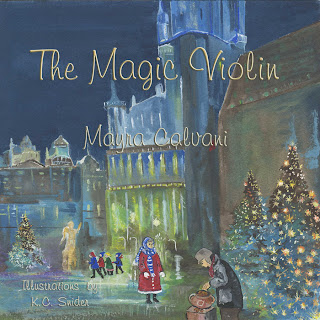
More than anything, 8-year old Melina wants to become a good violinist. When she loses confidence, her Rumanian teacher Andrea decides it’s time for a magic dose of self esteem. A mysterious, old woman in rags gives Melina some curious advice; a violinist Russian hamster, who happens to live under the old woman's hat, offers her a virtuoso performance; a shooting star fills her with hope on Christmas Eve. Is Melina actually playing better, or has her violin become magic? Who is the old woman in the townsquare, and why does she wear the same emerald ring as her teacher Andrea?
The message of The Magic Violin is that real magic lies in believing in oneself, and that if we trust ourselves, we can accomplish anything. The story, written for 5 to 8 year olds, shows how being compassionate and generous can have its rewards. It also introduces children to music and other countries--Belgium, in this case.
This will be my first--and hopefully not last!--violin-related children's book. People who know me are familiar with my love for the violin and how it has inspired my work.
Blog: Cachibachis (Login to Add to MyJacketFlap)
JacketFlap tags: children's writer, Mayra's Secret Bookcase, Belgium, Mayra Calvani, Add a tag
Mayra Calvani, a children's author I am currently working on a project with, has just started a new blog. Mayra's Secret Bookcase. She is an accomplished writer, and I am honored to be creating illustrations for a picture book she has written.







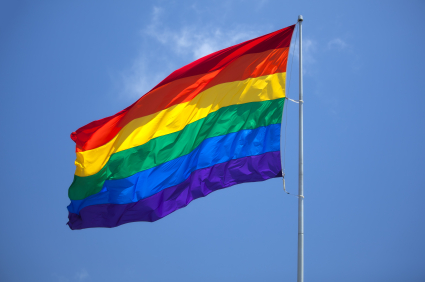
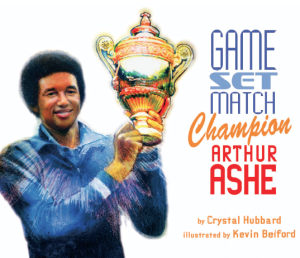
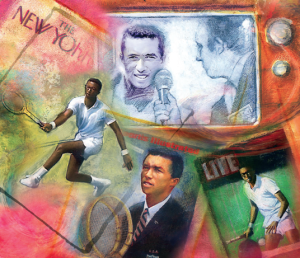
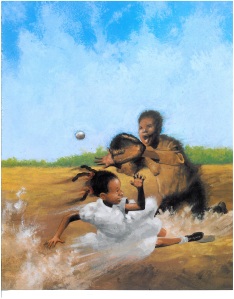
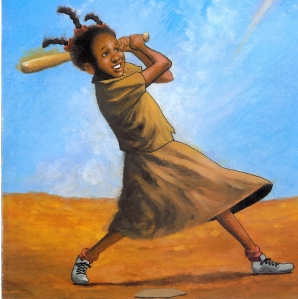

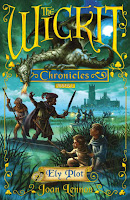
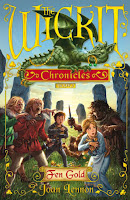


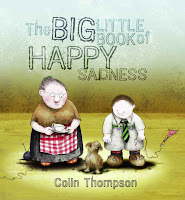
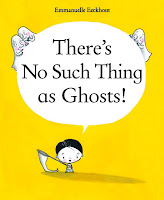
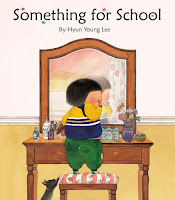


[...] Black History Month: Why Remember Arthur Ashe? [...]
[...] Black History Month: Why Remember Arthur Ashe? [...]